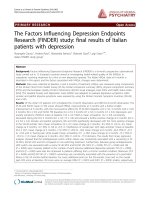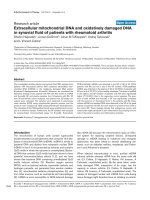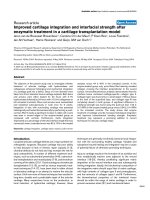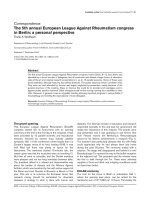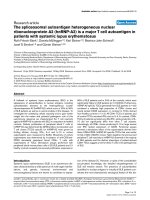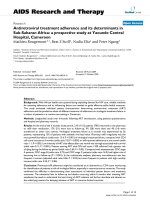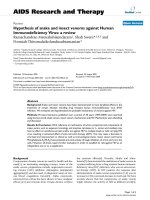Báo cáo y học: "The relaxation exercise and social support trialresst: study protocol for a randomized community based trial" potx
Bạn đang xem bản rút gọn của tài liệu. Xem và tải ngay bản đầy đủ của tài liệu tại đây (250.03 KB, 8 trang )
STUD Y PRO T O C O L Open Access
The relaxation exercise and social support trial-
resst: study protocol for a randomized
community based trial
Loulou Kobeissi
1,2*
, Ricardo Araya
3
, Fayssal El Kak
4
, Zeina Ghantous
2
, Marwan Khawaja
2
, Brigitte Khoury
5
,
Ziyad Mahfoud
6
, Rima Nakkash
7
, Tim J Peters
8
, Sami Ramia
9
and Huda Zurayk
2
Abstract
Background: Studies suggests a possible link between vaginal discharge and common mental distress, as well as
highlight the implications of the subjective burden of disease and its link with mental health.
Methods/Design: This is a community-based intervention trial that aims to evaluate the impact of a psycho-social
intervention on medically unexplained vaginal discharge (MUVD) in a group of married, low-income Lebanese
women, aged 18-49, and suffering from low to moderate levels of anxiety and/or depression. The intervention
consisted of 12 sessions of structured social support, problem solving techniques, group discussions and trainer-
supervised relaxation exercises (twice per week over six weeks). Women were recruited from Hey el Selloum, a
southern disadvantaged suburb of Beirut, Lebanon, during an open recruitment campaign. The primary outcome
was self-reported MUVD, upon ruling out reproductive tract infections (RTIs), through lab analysis. Anxiety and/or
depression symptoms were the secondary outcomes for this trial. These were assessed using an Arabic validated
version of the Hopkins Symptoms Checklist-25 (HSCL-25). Assessments were done at baseline and six months using
face-to face interviews, pelvic examinations and laboratory tests. Women were randomized into either intervention
or control group. Intent to treat analysis will be used.
Discussion: The results will indicate whether the proposed psycho social intervention was effective in reducing
MUVD (possibly mediate d by common mental distress).
Trial Registration: The trial is registered at the Wellcome Trust Registry, ISRCTN assigned: ISRCTN: ISRCTN98441241
Background
The Urban Health Study (UHS) undertaken in 2002-2003
provided the baseline survey data for the proposed inter-
vention in Hey el Sellom. The UHS sample consisted of
3,100 households from three communities (Nabaa, Burj
el Barajneh and Hay el Selloum) located in Beirut’spoor
and rapidly changing suburbs. All ever-married women
(n = 1899) found in these selected households were sub-
sequently interviewed to providedataonthesocialcon-
text of health, among which reproductive health.
The UHS findings indicated that abnormal vaginal dis-
charge was a common complaint in Hey el Selloum.
38% of ever-married women aged 1 5-59 years in Hey el
Sellom [1] complained of vaginal discharge, of whom
71% reported being ‘ bothered’ by the complaint. Of
those reporting vag inal discharge, 64% already consulted
a health provider or planned to do so, of whom only a
few actually reported having reproductiv e tract
infections.
It has b een e stimated that more than half of the
women in the Arab world suffer from symptoms asso-
ciated with reproductive health problems; and the most
commonly reported symptom is vaginal dischar ge [2-4].
Increasing evidence, on the other hand, indicates the
poor association between reported symptoms of repro-
ductive health problems and medically diagnosed dis-
eases [5-9]. Vaginal disc harge, being the most common
reported gynaecological symptom of RTIs, has recently
* Correspondence:
1
UCLA, School of Public Health, Community Healt h Sciences Department,
650 E Charles Young Dr, Los Angeles, California 90095, USA
Full list of author information is available at the end of the article
Kobeissi et al. BMC Psychiatry 2011, 11:142
/>© 2011 Kobeissi et al; licensee BioMed Central Ltd. Th is is an Open Access article distrib uted under the terms of the Creati ve Commons
Attribution License ( w hich permits unrestricted use, distribution, and repro duction in
any medium, provided the or igina l work is properly cited.
received more attention [1,5,10-12]. Patel V. et al.,
(2005), in a population-based survey conducted in Goa,
India, showed the lack of association between com-
plaints of vaginal discharge and the presence of medi-
cally diagnosed reproductive tract infections (RTIs). In
another community-based study, cond ucted in three vil-
lages of Giza in Egypt, a similar finding was also
observed. 77% of interviewed women in the study
reported abnormal vaginal discharge, among whom 52%
actually suffered from the presence of one or more RTIs
[5]. In addition to the UHS, a study in Lebanon [6] con-
ducted in Nebi Shite- Lebanese community, which
shares similar socio-demographic characteristics to Hey
el Sellom, showed similar observations. 24.5% of the
women in the Nebi Shite survey reported vaginal dis-
charge, while only 9.3% of these women actually suffered
from RTIs.
From a woman’s perspecti ve, the subjective burden of
self-perceived illness and abnormality can be as impor-
tant as a result of disease due to a biomedical confirmed
condition. For example, in Muslim communities, vaginal
discharge is considered troublesome because it affects
the woman’s prayer requirements to be “clean” [7]. Self-
perceived illness and abnormality also affect health-seek-
ing behaviour, leading often to unnecessary spending on
health care and ineffective management [8,9]. In fact,
the syndromic management of vaginal discharge can
lead to inappropriate treatment of a large proportion of
women, as well as unnecessary spending on treatment
of non-existing RTIs [8,13].
An alternative explanation to MUVD has been
recently suggested. Several observational studies con-
firmed the contribution of anxiety and depression to
medically unexplained gynaecological symptoms, such as
pelvic pain and abnormal vaginal discharge [5,12,14-22].
Taking the already discussed UHS, the sub-sample ana-
lysis pertaining to Hey el Selloum sample, showed that a
large proportion of women (42%) reported mental dis-
tress- as assessed by GHQ-12. Moreover, multivariate
analysis showed that mental distress was significantly
associated with reported abnormal vaginal discharge,
after adjusting for relevant risk factors and reported
RTIs [23]. Women considered stress to be a main cause
of their discharge [24] and identified mental as well as
psychological health as important elements contributing
to their perception of good reproductive health [4]. The
UHS also showed that both mental distress and reported
gynaecological health problems were negatively asso-
ciated with social support [25].
Along the same line, population-based studies from
South Asia show significant associations bet ween com-
plaints of vaginal discharge and psychosocial stress, in
addition to psychosomatic symptoms such as dizziness,
backache, and weakness [12,14,26]. Qualitative studies
in India indicated that women typically associate com-
plaints of discharge with mental stress and related
symptoms such as tiredness [12]. On the other hand,
social support is consistently associated with common
mental disorders (CMD) and physical conditions [27].
Improvements in social support were shown to lead to
lower consultation rates [27,28] and reduced sickness
absences [29].
These findings have important implications for alter-
native intervention strategies. Our proposed psychoso-
cial intervention carried out in this trial (consisting of
relaxing exercise and social support) aims to reduce
MUVD as a result of reducing CMDs. There are only a
few randomized controlled trials (RCTs) for the treat-
ment of CMDs in the developing world [30-33]. Most of
these studies have used traditional psycholo gical models
such as Cogniti ve Behavioural Therapy and/or Interper-
sonal Therapy to alleviate CMDs [34,35]. However,
some studies in the West have shown the effectiveness
of simpler alternative approaches such as problem sol-
ving [36,37] and group support strategies [30,38-43].
Similarly, different RCTs have demonstrated that pro-
gressive muscle relaxation and/or guided imagery can
alleviate depressive symptoms by enhancing self efficacy
and decreasing persistent unexplained physical symp-
toms [43-47].
We conducted a community-based randomized trial,
comparing the expe rimental group (who were adminis-
tered the psychosocial intervention) with the control
group (who served as a treat later group). The research
question is the following: Does a community based
psycho-social intervention (combined structu red social
support groups and progressive relaxing exercises) alter
complaints from medically unexplained vaginal dis-
charge among low-income married women, aged 18-49
and residing in Hey el Sellom?
Methods/Design
Design
A community-based randomized trial was conducted to
evaluate the i mpact of a psychosocial intervention o n
medically unexplained vaginal discharge (MUVD) in a
group of married, low-income Lebanese women, aged
18-49, and suffering from low to moderate levels of
common mental disorders (CMD) (anxiety and/or
depression). The trial consisted of two arms: (a) Women
in the experimental group who received psy chosocial
intervention, (b) women in the control group (treat
later). The institutional review board of the American
University of Beirut approved the study protocol.
Setting & Study Population
The trial took place in Hey el Sellom, a neighbourhood
located in the southern suburbs of Beirut, Lebanon. It is
Kobeissi et al. BMC Psychiatry 2011, 11:142
/>Page 2 of 8
a large informal settlement of an estimated population
of 150,000 (mainly Lebanese Shiites). The area suffers
from official neglect and lacks basic he alth, education
and physical infrastructure. Data from the UHS show
that up to 60 per cent of inhabitants consider them-
selves ‘poor’. Women have low education, with about 1
out of 4 women only reaching elementary school (1).
Study Inclusion Criteria
- Currently married women, 18-49 years of age
- Women who reported symptoms of vaginal dis-
charge confirmed by medical exam to be MUVD
- Women who scored low to moderate levels of
Common Mental Disorders (CMDs) , based o n the
study screening tool for common mental disorders
(Hopkins Checklist 25)
- Women who were willing to take part in the study
by signing an informed consent after listening to our
explanation of the study process
- Women who upon screening had none of the
exclusion criteria listed below
Study Exclusion Criteria
- Pregnancy
- Menopause
- Less than 8 weeks postpartum
- Hysterectomy
- Women who score very low or severe levels of
CMDs,
- Women who report having been treated for severe
mental illness such as bipolar depression, schizo-
phrenia and suicidal plans
Sample Size
The sample size calculation was based on the primary
outcome of reported MUVD at six months. Allowing for
10%attrition,asamplesizeof80-102ineachgroup
would provide 80-90% po wer to detect a difference of
20 percentage points (for example, 10% vs. 30%) in the
proportion reporting MUVD at 6 months, using a 2-
sided 5% significance level . There is no previous study
that can directly inform the effect size likely for this
outcome, but studies have found differences in recovery
rates for CMD of u p to 40% between usual care and
active interventions for common mental disorders (4,
10, 11). We have opted for a 20 percentage point differ-
ence given t hese previous studies on CMD and our jud-
gement that this is both a clinically significant and
plausible difference in MUVD rates.
Recruitment
Sample r ecruitment was facilitated by adopting a com-
munity-based participatory research approach. The
recruitment of the women, the medical assessments, t he
data collection and the delivery of the intervention pack-
age was facilitated by our trial stakeholders: the Ministry
of Social Affairs and Amel association. It was also facili-
tated by the assistance and support of the available
schools, factories, gynaecological clinics, and satellite
network providers found in the area. It was ensured that
thedifferentcommunitycounterpartswereevenlydis-
tributed throughout the 11 different community neigh-
bourhoods of Hey el Selloum. During recruitment, a
baseline questionnaire w as administered to determine
whether or not the women initially met th e trial’s inclu-
sion criteria. Women reporting vaginal discharge were
referred to undertake a pelvic as well as laborato ry
check up- to rule out the presence of RTIs (following
informed consent). Women who did not report a ny
vaginal discharge were referred for a general physical
exam, unless they insisted to undertake the pelvic and
laboratory checkups.
Randomization and Procedure
Randomization was performed using a computer-gener-
ated allocation schedule, produced by an individual not
involved in the recruitm ent process. The original proto-
col was that the baseline measures and consent were
planned to be obtained before allocation was determined
remotely (by telephone) and then revealed to the
woman. In the event, logistical constraints at the recruit-
men t cent res meant that remote allocati on was not fea-
sible and allocation was performed using the same
computerized system as originally intended, but in the
field rather than remotely. An unplanned consequence
of this change in procedure was that the women were
informed of their allocation before they gave written
consent.
The women were informed of their allocation into
either the intervention or the contro l arm (treat later
and given the intervention after the 6 months follow up)
when they returned to pick up their laboratory results.
Women who did not obtain their results were contacted
by telephone, up to a maximum of three times.
Blinding on the intervention status was not possible
for both logistic and ethical reasons, especially as knowl-
edge of involvement in the intervention was integral to
its delivery.
Intervention
The i ntervention package was given for six weeks. The
package combined t rainer-supervised relaxation exer-
cises (twice per week for 30 minutes/session) a nd psy-
cho-educational group discussions (twice per week for
75 minutes/session). The order of eac h session was
determined by practical circumstances. The trainer-
supervised relaxation exercises consisted of progressive
muscle relaxation, guided imagery, str etching and
Kobeissi et al. BMC Psychiatry 2011, 11:142
/>Page 3 of 8
breathing, and progressive resistance exercise. The psy-
cho-educational sessions were divided into directed and
semi-structured social support discussion sessions,
incorporating problem solving skills building as well as
venting. The relaxation exercises were given, over six
weeks by trained physical fitness instructors, and the
group discussions were given by clinical psychologists
and a ssisted by co-moderates who were social workers.
The fitness instructors were trained prior to t he inter-
vention by a specialist in muscle relaxation and guide
imagery. Similarly, the clinical psychologists received
two days of training from a senior clinical psychologist,
and were provided with a manual that describes in detail
each of the 12 sessions. To ensure coherence among
group mem bers, once a group was formed its members
remained in the same group throughout the intervention
period. The benefits to women enrolled in the trial
included: the provision of free childcare during sessions,
free pelvic exam, and free laboratory tests.
No major risks were anticipated for the participating
women in this trial. There were potentially some dis-
comforting issues, such as repeated pelvic exam and
laboratory tests at baseline and at six months, an active
commitment to attend sessions throughout the 6 weeks
intervention periods, as well as answering some sensitive
questions during the interview questionnaires. On the
other hand, the control group were provided with a per-
iodic mental health assessment during intervention
delivery, free pelvic exam and laboratory tests at baseline
and six months.
In particular, for the control (treat later) group, two
clinical psychologists monitored them closely (every
three weeks) by assessing their depression/suicidal sta-
tus via administering the Arabic validated Hopkins
Checklist-25 (depression subscale, which is comprised
of 15 questions to measure depression coupled with an
additional question on any plans to commit suicide
during the past week). This was perceived to be more
ethical to ensure that their CMD status did not worsen
during the intervention period for the experimental
group. All women with severe depression or who
reported plans to commit suicide (whether in the
intervention or control group) were referred for free
follow-up visits at a community psychiatric clinic,
belonging to Medicins Sans Frontier and located in
close proximity to Hey el Selloum, in a neighbourhood
called Burj el Barajneh.
As for the intervention package, it should be noted
that the components and the duration of the interven-
tion package were supported by evidence-based litera-
ture findings pertaining to the positive impact o f
structured social support on disease [48-57] and mental
health outcomes [30,38-43,55-57]. The literature also
indicates the positive impacts of progressive muscle
relaxation and/or guided imagery on mental health and
persistent unexplained physical symptoms [44-47].
It s hould be noted that the particular use of this psy-
chosocial intervention, as opposed to other more sophis-
ticated psychological based metho ds (cognitive
behavioural therapy [CBT] or interpersonal therapy
[IPT]), was motivated by the fact that it requires less
training and is perceived to be more culturally accepta-
ble, in a conservative-economically disadvantaged Mus-
lim community. The other methods require a larger
number of well-trained experts as well as longer training
periods before actual implementation, which is beyond
the capacities of the trial community. The overarching
aim of this trial was to adopt a simple low cost commu-
nity-based approach (that requires moderate levels of
education and experience), with the hope to be later
taken over (if proved effective) by the local community
centres.Itshouldbenotedthatthedifferentinterven-
tion components were pilot-tested fo r adequacy, appro-
priateness and cultural acceptability before actual
implementation.
The semi-structured support (SSS) sessions were
designed to be partially directed, with semi-structured
components. They also incorporated trainings on pro-
blem solving and social support. The aim behind this
combination was to enable women to participate in the
discussion as well as to build ra pport. The main des ired
outcomes of the SSS components were: empathy, vent-
ing and problem solving.
The relaxation exercise component of the intervention
aimed to train the women on how to engage in guided
imagery exercises in their own homes. It was unlikely
considered that if the women replicate some of the phy-
sicalfitnesscomponentsathomeorinformother
women about these components (for example some
womeninthecontrolgroup)thiswouldresultincon-
tamination. Besides, the relaxation exercise sessions
were progressiv e in nature, i.e. did not follow the same
routine, starting at 15 minutes and building up resis-
tance to r each 30 minutes. This also contributes to a
lower probability of contamination.
Each new session of the relaxat ion exercise p ackage
was designed to wrap up the techniques conducted in
the previous sessions, touch upon what is being prac-
ticed at home and proceed by adding an additional new
technique.
Attendance was c ontinuously monitored at the begin-
ning of each session (SSS and relaxation exercise). A
checklist was also used to indicate the techniques learnt
in sessions, techniques practised at home, etc.
Instruments
The primary outcome is MUVD a t six months. A
woman is considered to have M UVD, if she reports a
Kobeissi et al. BMC Psychiatry 2011, 11:142
/>Page 4 of 8
complaint of vaginal discharge as assessed by the ques-
tion:” are you complaining currently from vaginal dis-
charge?” and is concurrently not suffering from any
RTIs, a s confirmed by pelvic exam and laboratory tests
(using swabs). Further questions were also asked of the
women to note whether or not they are bothered by
MUVD,aswellastoindicatethecolour,odour,thick-
ness, consistency and frequency of discharge. Besides,
relevant health service use such as consultations for
vaginal discharge and associated treatments were also
explored.
The secondary outcomes include
- CMD: the Hopkins Symptom Checklist 25 (HSCL-25)
(individual scores on anxiety and/or depression > 1.99
are considered symptomatic was used to assess common
mental disorders). The HSCL-25 is known to have good
psychometric measures [58-61 ]. This s tudy instrument
was field tested for validity and internal consistency on a
convenience sample of 153 currently married women,
aged 18-49, living in similar conditions in a different area
(Ma3amourrah) of the study target group using the MINI
International Neuropsychiatric Interview to serve as the
diagnostic criteria. For HSCL-25 depression, we recom-
mend the use of 2.10 as the cut off value. This cut off
value showed a good balance between sensitivity and spe-
cificity, NPV and PPV. It also had the highest kappa value
(0.47) among all the other cut offs. As for the HSCL-25
anxiety subscale, the cut off value of choice was 2 .00.
This value showed a good balance among the various
measures and the highest kappa value. The Mini Interna-
tional Neuropsychiatric Interview (MINI) was chosen as
the gold standard since it has been validated in Arabic
against the Composite International Diagnostic Interview
(CIDI) [62]. It has also been validated in Moroccan collo-
quial Arabic using expert diagnosis by Kadri et al in 2005
[63]. Both validation processes showed that MINI
demonstrated good psychometric properties.
- Somatisation: assessed using The Scale for Assess-
ment of Somatic Symptoms (SASS) - the Patel Somati-
sation Scale, 2005. This scale h as been shown to have
good psychometric measures in Asian countries [17]. It
measures four clusters o f somatic symptoms: pain
related symptoms (5 questions), sensory somatic symp-
toms (5 questions), non specific somatic symptoms (5
questions), biological function related symptoms (5
que stions). For the purpose of our trial , it was validated
by face validity using the expertise of mental health
experts.
Other measures/cofactors included
- Socio-demographic factors: age, education, employ-
ment status, family composition (presence of extended
family members), number of children present (by age of
each child), housing tenure (ow ned or rental), number
of rooms, and household income.
-Women’ s reproductive and obstetric history (e.g.
pregnancies, live births, abortions, still births).
- Social Support: assessed using questions from the
Urban Health Survey, already translated into Arabic.
Timing of assessments
Data were collected at the screening phase, at 1.5
monthsandatsixmonths,withMUVDassessedat
baseline and six months. CMDs were assessed at screen-
ing, at 1.5 and at six months after randomisation, and
somatisation was assessed at baseline and at six months.
The laboratory tests to rule out RTIs were assessed at
baseline and at six months. The socio-demographic
characteristics and reproductive history of the women
were assessed only at baseline, while, social support fac-
tors were assessed at both baseline and at six months.
Analyses
The trial will be analyzed and reported in accordance
with the CONSORT guidelines. A n interim analysis was
not planned for this trial. Descriptive statistics will be
used to compare the two groups as randomized. The
primary analysis will comprise the difference in the per-
centages of wome n with MUVD at 6 months between
the groups as randomized (including the 95% confidence
interval) and the number-needed-to-treat. Logistic
regression analyses (for the primary and secondary out-
comes) will be used to adjust for any baseline imbal-
ances, and imputation methods will be used to replace
missing outcome data. Clustering effects of the interven-
tion groups will be accounted for using methods such as
robust standard errors and mixed effects regression
mode ls. Potenti al mediators will be investigate d by add-
ing ( separately) changes in HSCL-25 Anxiety and
Depression sub-scales and the somatisation scale scores
to the regression models with the primary outcome.
Adherence to the intervention will be accounted for
using instrumental variables regression models. Appro-
priate interaction terms will be added to the regression
models for the primary a nd secondary outcomes to
investigate differential effects of the intervention accord-
ing to age and baseline HSCL-25 scores, all as continu-
ous variables.
Discussion
The approach adopted for the randomized trial ensured
the involvement of the community throughout the dif-
ferent stages of the trial: preparation, recruitment, train-
ing on intervention and data collection, as well data
analysis, data reporting and dissemination. Two commit-
tees that are representative of the women in the com-
munity of Hey el Selloum were formed. The purpose of
these two committees was to ensure that woman’ s
voices (specifically are the grass root level) are being
heard, in order to: better understand their language,
Kobeissi et al. BMC Psychiatry 2011, 11:142
/>Page 5 of 8
better service to their needs, as well as understand the
cultural context. These two committees were the Local
Women Committee (LWC) and the Community Advi-
sory Board (CAB). The LWC was composed of repre-
sentative women from the community with good
outreach experience and sound interaction with the
local w omen in Hey el Se lloum. The LWC meets regu-
larly on a weekly basis. The CAB, on the other hand,
was composed of two representatives from the different
community stakeholders who are involved in this trial.
The CAB served as the supervisory/monitoring liaison
between the technica l research team represented by the
steering committee and the community. The CAB met
on a bi-weekly/monthly basis or as deemed necessary
during preparatory phase and the intervention delivery
periods. These two committ ees were established follow-
ing a comprehensive community mapping, establishing
contacts with all stakeholders, qualitative interviews
with men and women and focus groups with commu-
nity midwives in order to assess the trial’saswellasthe
intervention’s feasibility.
The study results will be disseminated to the public
once the analysis of the trial is completed. Results’ disse-
mination will be at three different levels: the CAB, the
LWC and the community at large. The language and
degree of complexity of the dissemination efforts will
take into account the educational level, cultural issues,
and inherent social characteristics of the receiving
audience.
This trial p resents a novel intervention strategy in
reproductive as well as mental health research. The trial
aims to assess the impact of a simple, low cost, cultu-
rally appropriate psychosocial intervention on alleviating
the symptoms of reported MUVD, among a group of
low-income Lebanese married women aged 18-49, resid-
ing in Hay el Selloum (a southern disadvantaged suburb
in Beirut, Lebanon), suffering from low-moderate levels
of common mental distress (anxiety and/or depression).
The intervention was a six-weeks (twice per week)
package, consisting of relaxation exercises and social
support.
The proposed intervention package also seemed more
appropriate for a setting such as Lebanon, given the lim-
ited availability of adequately trained psychotherapists,
limited financial resources coupled with the high rates
of CMDs in the country (in light of lack of a national-
based insurance co verage for such conditions, and abuse
of over the counter tranquilizers and sedatives) [64-66].
Ethical approval
This trial gained ethical approval by the Institutional
Review Board of the American University of Beirut.
Acknowledgements
We are grateful to the Local Women Committee: Asmahan, Fatima, Huda,
Mariam, Tharwat, and Zeinab, and to all the women who made this research
possible.
Funding
This trial was funded by the generous support of Wellcome Trust.
Author details
1
UCLA, School of Public Health, Community Healt h Sciences Department,
650 E Charles Young Dr, Los Angeles, California 90095, USA.
2
Center for
Research on Population and Health, Epidemiology and Population Health
Department, Faculty of Health Sciences, American University of Beirut, Beirut,
Lebanon.
3
Academic Unit of Psychiatry, School of Social and Community
Medicine, University of Bristol, Bristol, UK.
4
Department of Health Promotion
and Community Health, Faculty of Health Sciences, American University of
Beirut, Beirut, Lebanon.
5
Department of Psychiatry, Faculty of Medicine,
American University of Beir ut, Beirut, Lebanon.
6
Department of Public Health,
Weill Cornell Medical College, Doha, Qatar.
7
Center for Research on
Population and Health, Department of Health Promotion and Community
Health, Faculty of Health Sciences, American University of Beirut, Beirut,
Lebanon.
8
School of Clinical Sciences, University of Bristol, Bristol, UK.
9
Medical Lab Sciences Program, Faculty of Health Sciences, American
University of Beirut, Beirut, Lebanon.
Authors’ contributions
All authors have contributed to, read and approved this manuscript.
Competing interests
The authors declare that they have no competing interests.
Received: 21 June 2011 Accepted: 25 August 2011
Published: 25 August 2011
References
1. Khawaja M, et al: Symptoms of gynaecological morbidity and mental
distress among women in low income urban neighbourhoods of, Beirut,
Lebanon. Journal of Women’s Health 2009, 18(10):1701-8.
2. Al-Qutob R, Schmidt A: Measuring reproductive morbidity: A community-
based approach, Jordan. Health Care for Women International 2003,
24:635-649.
3. Talaat M, Watts S, Mekheimar S, Farook AH, Hamed H: The social context
of reproductive health in an Egyptian hamlet: A pilot study to identify
female genital schistosomiasis. Social Science and Medicine 2004,
58:515-524.
4. Zurayk H, et al: Rethinking family planning policy in light of reproductive
health research. Policy Series in Reproductive Health 1 Population Council
Regional Office for West Asia and North Africa; 1994.
5. Prasad J, Abraham S, Akila B, Joseph A, Jacob KS: Symptoms related to the
reproductive tract and mental health among women in rural Southern
India. The National Medical Journal of India 2003, 16(6):303-308.
6. Deeb ME, Awwad J, Yeretzian JS, Kaspar HG: Prevalence of reproductive
tract infections, genital prolapse, and obesity in a rural community in
Lebanon. Bulletin of the World Health Organization 2003, 81(9):639-645.
7. Chaliha C, Stanton SL: The ethnic, cultural and social aspects of
incontinence-a pilot study. International Urogynecology Journal 1999,
10:166-170.
8. Trollope-Kumar K: Limitations of the syndromic approach in South Asia.
International Journal of Epidemiology 2005, 34(5):1173
9. Bhatia JC, Cleland J: Self-reported symptoms of gynaecological morbidity
and their treatment in South India. Studies in Family Planning 1995,
26:203-216.
10. Khattab H, Younis N, Zurayk : Women, Reproduction, and Health in Rural
Egypt: The Giza Study. Cairo. The American University of Cairo Press; 1999.
11. Zurayk H, Khattab H, Younis N, Kamal O, El-Helw M: Comparing women’s
reports with medical diagnoses of reproductive morbidity conditions in
rural Egypt. Studies in Family Planning 1995, 26(1):14-21.
12. Patel V, Oomman N: Mental health matters too: Gynaecological
symptoms and depression in South Asia. Reproductive Health Matters
1999, 7(14):30-38.
Kobeissi et al. BMC Psychiatry 2011, 11:142
/>Page 6 of 8
13. Tsui AO, Haaga J: Reproductive Health in Developing Countries. Expanding
Dimensions, Building Solutions Washington DC: National Academy Press;
1997.
14. Patel V, Pednekar S, Weiss H, Rodrigues M, Barros P, Nayak B, Tanksale V,
West B, Nevrekar P, Kirkwood BR, Mabey D: Why do women complain of
vaginal discharge? A population survey of infectious and psychosocial
risk factors in a South Asian community. International Journal of
Epidemiology 2005, 34:853-862.
15. Rannestad T, Eikeland OJ, Helland H, Qvarnstrom U: Quality of life, pain,
and psychological well-being in women suffering from gynaecological
disorders. Journal of Women’s Health & Gender-based Medicine 2000,
9(8):897-903.
16. Hodgkiss AD, Sufraz R, Watson JP: Psychiatric morbidity and illness
behaviour in women with chronic pelvic pain. Journal of Psychosomatic
Research 1994, 38(1):3-9.
17. Rosenthal RH: Psychology of Chronic Pelvic Pain. Obstetrics & Gynaecology
Clinics of North America 1993, 20(4):627-642.
18. Slocumb JC, Kellner R, Rosenfeld RC, Pathak D: Anxiety and depression in
patients with the abdominal pelvic pain syndrome. General Hospital
Psychiatry 1989, 11(1):48-53.
19. Byrne P: Psychiatric morbidity in a gynaecology clinic: An
epidemiological survey. British Journal of Psychiatry 1984, 144:28-34.
20. Piccinelli M, Wilkinson G: Gender differences in depression: critical review.
Canadian Journal of Psychiatry 2002, 177:486-92.
21. Rojas G, Araya R, Lewis G: Sex inequalities and common mental disorders:
comparing Chile and Great Britain. Social Science and Medicine 2005,
60(8):1693-703.
22. Patel V, Araya R, Ludemir A, Todd C, Lima M: Women, poverty and
common mental disorders in four restructuring societies. Social Science
and Medicine 1999, 49(11):1461-71.
23. Saab BR, Salem MT, Chaaya M, Campbell OM: Psychological distress
among marginalized women in the outskirts of Beirut: Determinants
and association with health perception. Journal of Urban Health 2005,
82(4):653-665.
24. Zurayk H, Myntti C, Salem MT, Kaddour A, El-Kak F, Jabbour S: Beyond
reproductive health: Listening to women about their health in
disadvantaged Beirut neighbourhoods. Health Care for Women
International .
25. Kaddour A, Hafez R, Zurayk H: Women’s perception of reproductive
health in three communities around Beirut, Lebanon. Reproductive Health
Matters 2005, 13(25):34-42.
26. Berkman L, Glass T: Social Integration. In
Social Networks, Social Support,
and
Health 1 edition. Edited by: Berkman L, Kawachi I. Social Epidemiology.
New York: Oxford University Press; 2000:137-73.
27. Ten Have M, Vollebergh W, Bijl R, Ormel J: Combined effect of mental
disorder and low social support on care service use for mental health
problems in the Dutch general population. Psychological Medicine 2002,
32:311-23.
28. Stansfeld SA, Rael EG, Shipley MJ, Marmot M: Social support and
psychiatric sickness absence: A prospective study of British civil servants.
Psychological Medicine 1997, 27:35-48.
29. Saxena S, Paraje G, Sharan P, Karam G, Sadana R: The 10/90 divide in
mental health research: trends over a 10-year period. Br J Psychiatry 2006,
188:81-2.
30. Araya R, Rojas G, Fritsch R, Gaete J, Rojas M, Simon G, et al: Treating
depression in primary care in low-income women in Santiago, Chile.
Lancet 2003, 361(9362):995-1000.
31. Bolton P, Bass J, Neugebauer R, et al: Group Interpersonal Psychotherapy
for Depression in Rural Uganda. Journal of the American Medical
Association 2003, 289:3117-3124.
32. Waitzkin H, Iriart C, Estrada A, Lamadrid S: Social medicine in Latin
America: productivity and dangers facing the major national groups.
Lancet 2001, 358(9278):315-23.
33. Mynors-Wallis L, Davies I, Gray A, Barbour F, Gath D: A randomised
controlled trial and cost analysis of problem-solving treatment for
emotional disorders given by community nurses in primary care. British
Journal of Psychiatry 1997, 170:113-9.
34. Bass J, Neugebauer R, Clougherty KF, Verdeli H, Wickramaratne P,
Ndogoni L, et al: Group interpersonal psychotherapy for depression in
rural Uganda: 6-month outcomes. The British Journal of Psychiatry 2006,
188:567-573.
35. Bolton P, Bass J, Neugebauer R, Verdeli H, Clougherty KF, Wickramaratne P,
et al: Group interpersonal psychotherapy for depression in rural Uganda:
a randomized controlled trial. JAMA 2003, 289:3117-24.
36. Mynors-Wallis L, Gath DH, Day A, Baker F: Randomised controlled trial of
problem solving treatment, antidepressant medication, and combined
treatment for major depression in primary care. British Medical Journal
2000, 320:26-30.
37. Gamble C, Hart C: The use of psychosocial interventions. Nursing Times
2003, 99(9):46-47.
38. Magliano L, Marasco C, Fiorillo A, Malangone C, Guarneri M, Maj M, Working
Group of the Italian National Study on Families of Persons with
Schizophrenia: The impact of professional and social network support on
the burden of families of patients with schizophrenia in Italy. Acta
Physchiatrica Scandainvaica 2002, 106(4):291-298.
39. Sumathipala A, Hewege S, Hanwella R, Mann AH: Randomized
controlled
trial of cognitive behaviour therapy for repeated consultations for
medically unexplained complaints: A feasibility study in Sri Lanka.
Psychological Medicine 2000, 30(4):747-757.
40. Chen KM, Synder M, Krichbaum K: Tai chi and well-being of Taiwanese
community-dwelling elders. Clinical Gerontologist 2001, 24(3-4):137-156.
41. Ning Z, Esteves J, Lin Z, Qu Q: Depression and related factors in elderly of
Macao. Chinese Mental Health Journal 2001, 15(5):331-333, 335.
42. Li F, Duncan TE, Duncan SC, McAuley E, Chaumeton NR, Harmer P:
Enhancing the psychological well-being of elderly individuals through
Tai Chi exercise: A latent growth curve analysis. Structural Equation
Modelling: A Multidisciplinary Journal 2001, 8(1):53-83.
43. Krawczynski M, Olszewski H: Psychological well-being associated with a
physical activity programme for persons over 60 years old. Psychology of
Sport & Exercise 2000, 1(1):57-63.
44. Kominars KD: A study of visualization and addiction treatment. Journal of
Substance Abuse Treatment 1997, 14(3):213-223.
45. Baird CL, Sands L: A pilot study of the effectiveness of guided imagery
with progressive muscle relaxation to reduce chronic pain and mobility
difficulties of osteoarthritis. Pain Management Nursing 2004, 5(3):97-104.
46. Crook P, Rose M, Salmon P, Stott R, Peters S, Stanley I: Adherence to group
exercise: Physiotherapist-led experimental programmes. Physiotherapy
1998, 84(8):366-372.
47. Baider L, Peretz T, Hadani PE, Koch U: Psychological intervention in cancer
patients: A randomized study. General Hospital Psychiatry 2001,
23(5):272-277.
48. Telch CF, Telch MJ: Group coping skills instruction and supportive group
therapy for cancer patients: a comparison of strategies. Journal of
Consulting & Clinical Psychology 1986, 54(6):802-808.
49. Fung W, Chien W: The effectiveness of a mutual support group for
family caregivers of a relative with dementia. Archives of Psychiatric
Nursing 2002, 16(3) :134-144.
50. Manandhar DS, Osrin D, Shrestha BP, Mesko N, Morrison J,
Tumbahangphe KM, Tamang S, Thapa S, Shrestha D, Thapa B, Shrestha JR,
Wade A, Borghi J, Standing H, Manandhar M, De L, Costello AM, members
of the MIRA Makwanpur trial team: Effect of a participatory intervention
with women’s groups on birth outcomes in Nepal: Cluster-randomised
controlled trial. Lancet 2004, 364(9438):970-979.
51. Bryce RL, Stanley FJ, Garner JB: Randomized controlled trial of antenatal
social support to prevent preterm birth. British Journal of Obstetrics
Gynaecology 1991, 98(10):1001-1008.
52. Panzarella C, Alloy LB, Whitehouse WG:
Expanded hopelessness theory of
depression:
On the mechanisms by which social support protects
against depression. Cognitive Therapy & Research 2006, 30(3):307-333.
53. Lumley J, Watson L, Small R, Brown S, Mitchell C, Gunn J: PRISM (Program
of Resources, Information and Support for Mothers): A community-
randomised trial to reduce depression and improve women’s physical
health six months after birth. BMC Public Health 2006, 6(37).
54. Dennis CL: Psychosocial and psychological interventions for prevention
of postnatal depression: systematic review. BMJ 2005, 331(7507):15-22.
55. Constantino R, Kim Y, Crane PA: Effects of social support intervention on
health outcomes in residents of a domestic violence shelter: A pilot
study. Issues in Mental Health Nursing 2005, 26(6):575-590.
56. Scheidlinger S, Kahn GB: In the aftermath of September 11: group
interventions with traumatized children revisited. International Journal of
Group Psychotherapy 2005, 55(3):335-354.
Kobeissi et al. BMC Psychiatry 2011, 11:142
/>Page 7 of 8
57. Wiggins M, Oakley A, Roberts I, Turner H, Rajan L, Austerberry H, Mujica R,
Mugford M: The social support and family health study: A randomised
controlled trial and economic evaluation of two alternative forms of
postnatal support for mothers living in disadvantaged inner-city areas.
Health Technology Assessment 2004, 8(32):1-120.
58. Sandanger I, Moum T, Ingebrigtsen G, Sørensen T, Dalgard OS,
Bruusgaard D: The meaning and significance of caseness: the Hopkins
Symptom Checklist-25 and the Composite International Diagnostic
Interview II”. Social Psychiatry Epidemiology 1999, 34(1):53-9.
59. Sandanger I, Moum T, Ingebrigtsen G, Dalgard O, Sùrensen T, Bruusgaard D:
Concordance between symptom screening and diagnostic procedure:
the Hopkins Symptom Checklist-25 and the Composite International
Diagnostic Interview I”. Social Psychiatry Epidemiology 1998, 33:345-354.
60. Nettelbladt P, Hansson L, Stefansson CG, Borgquist L, Nordström G: Test
characteristics of the Hopkins Symptom Check List-25 (HSCL-25) in
Sweden, using the Present State Examination (PSE-9) as a caseness
criterion”. Social Psychiatry Epidemiology 1993, 28(3):130-133.
61. Kaaya SF, Fawzi MC, Mbwambo JK, Lee B, Msamanga GI, Fawzi W: Validity
of the Hopkins Symptom Checklist-25 amongst HIV-positive pregnant
women in Tanzania. Acta Psychiatrica Scandinavica Information 2002,
106(1):9-19.
62. Lecrubier Y, Sheehan D, Weiller E, Amorim P, Bonora I, Sheehan KH,
Janavs J, Dunbar G: The Mini International Neuropsychiatric Interview
(MINI). A short diagnostic structured interview: reliability and validity
according to CIDI. European Psychiatry 1997, 12(5):224-231.
63. Kadri N, et al: Moroccan colloquial Arabic version of the Mini
International Neuropsychiatric Interview (MINI): qualitative and
quantitative validation. European Psychiatry 2005, 20:193-195.
64. Sabbah I, Drouby N, Sabbah S, Retel-Rude N, Mercier M: Quality of life in
rural and urban populations in Lebanon using SF-36 health survey.
Health and quality of life outcomes 2003, 1:1-14.
65. Chahine LM, Chemali Z: Mental health care in Lebanon: policy, plans and
programmes. La Revue de Santé de la Méditerranée orientale 2009, 15(6),
Report.
66. Solberg KE: Lebanese turn to drugs to treat mental-health problems. The
Lancet 2008, 372:1137-1138, Report.
Pre-publication history
The pre-publication history for this paper can be accessed here:
/>doi:10.1186/1471-244X-11-142
Cite this article as: Kobeissi et al.: The relaxation exercise and social
support trial-resst: study protocol for a randomized community based
trial. BMC Psychiatry 2011 11:142.
Submit your next manuscript to BioMed Central
and take full advantage of:
• Convenient online submission
• Thorough peer review
• No space constraints or color figure charges
• Immediate publication on acceptance
• Inclusion in PubMed, CAS, Scopus and Google Scholar
• Research which is freely available for redistribution
Submit your manuscript at
www.biomedcentral.com/submit
Kobeissi et al. BMC Psychiatry 2011, 11:142
/>Page 8 of 8

